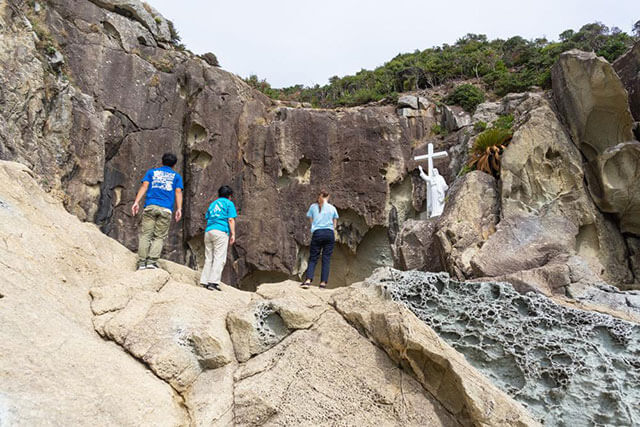
When Christianity was persecuted in the Japanese port cities where missionaries had once been welcomed, the Goto Islands provided refuge. Those that had converted and then faced death or torture for their beliefs became, on these islands not far off the coast, kakure—hidden—Christians. The traces of the persecuted remain all over the islands. The churches built after their rehabilitation are fascinating but to get the full experience, one has to travel by sea to the secret hideouts of the persecuted.
-
![]()
Recalling the roving commissions of the Roman Emperor Decius who set out to destroy the early Christian church, the Tokugawa shogunate set out to root out from the land all followers of the Christian faith. If they fled further inland, they risked eventual discover and sharing the fate of the Twenty Six Martyrs, the missionaries and local members of the Third Order of St. Francis crucified at Nagasaki. Even after taking to the water and landing on the islands, they did not venture into the villages and instead stayed in virtually inaccessible caves, safe from the prying eyes of local fishermen and villagers that might let slip the existence of their community.
![]()
The tour to see the remnants of the kakure departs from the tiny outport of Fukaura, led by a Mr. Sakai, fisherman and patriarch of a local house church that has its roots in the caves of Shinkamigoto. The boat chugs west, then sweeps down along the rugged coast. Apart from the chance to experience the caves of the hidden Christians, this is a likely the finest way to take in the coastal waters of the Goto Islands.
![]()
It was this landscape that gave refuge to the persecuted and although much has changed in the intervening three centuries, the caves of the Christians are still far off the beaten track. It would be a challenging three miles hike over thickly forested hills to reach the general area—the payoff for that trek would be sheer cliffs, dropping straight down to the sea. With the luxury of a guide and a motorboat, scrambling onto the stone slabs at the shoreline, one can still appreciate the lengths that the faithful went to to find refuge here.
![]()
Few physical traces remain of the hidden Christians, wiped away by the passage of time in this tough landscape, although Mr. Sakai is still able to point out the wide rock platform where mass was performed and a few marks left by pictures that once marked the cave walls. Nearby, a statue of Christ stands, a more recent erection. There is time to scramble around the caves for a while, and you can’t help but try to put together in your head how the people that escaped here would have lived.
![]()
As Jesus said in the Parable of the Sower, seeds that fall on rocky soil will eventually wither because they have no root. The fact is that even taking shelter in this remote, rocky redoubt was not enough to save the kakure. Legend has it that their cooking fires gave them away. Some accounts have the Christians being tortured; others say that they managed to escape to the other Goto Islands or set up communities further inland. Mr. Sakai is proof that the church lived on, in some form or another, and his father-in-law claims ancestry from among those first arrivals. He can show sacred objects, some Catholic, but others drawn from other religious traditions or simply unremarkable that the kakure considered sacred; the syncretic traditions of the hidden Christians were one way that they were able to practice their faith, even after losing touch with the Roman Church.
![]()
Mr. Sakai’s tour is one of a few operating in Shinkamigoto, these days. The islanders’ relationship to the history of hidden Christians is complicated, to say the least, but tours like this are way for those descended from the early Christian community, as well as those from other communities, to preserve something of the history of the islands—and, of course, pragmatism: it’s a good way to bring folks out to the Goto Islands.
- Kirishitan Cave
-
4.5
33 Reviews -
-
- Nagasaki Minamimatsuura-gun Shinkamigoto Cho Wakamatsugo
-
-
-
- 0959524964
-
View All







 Go here
Go here





